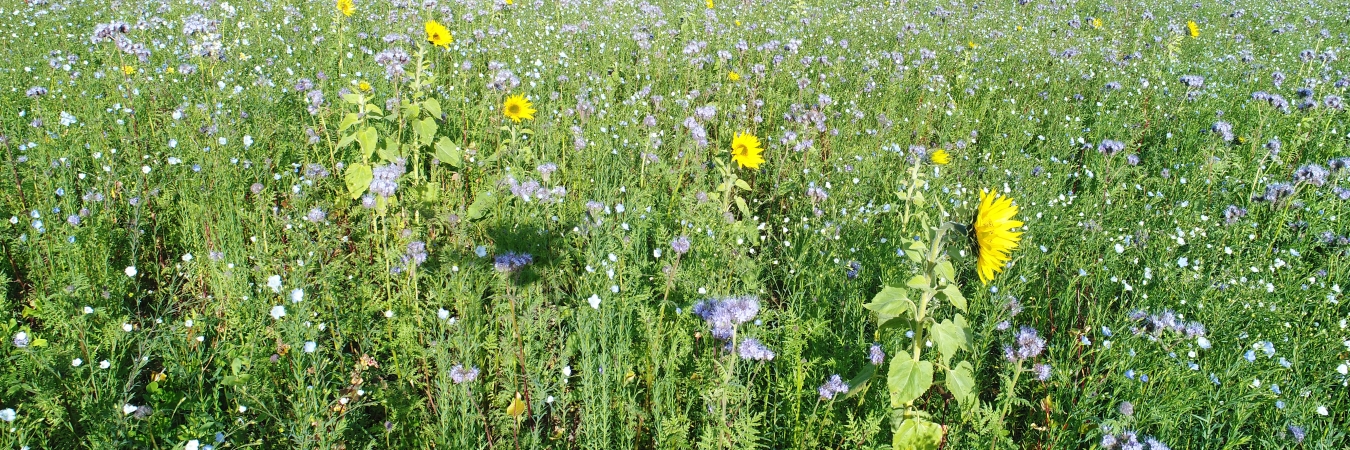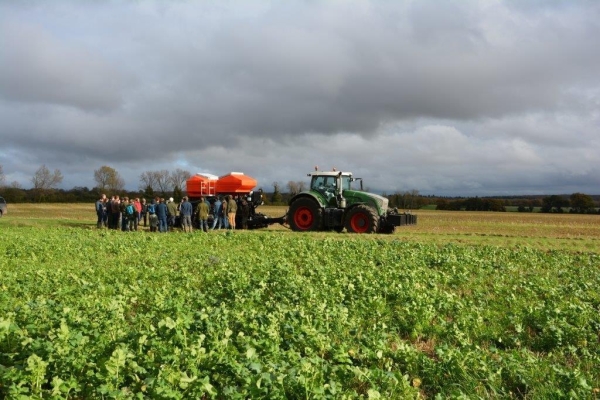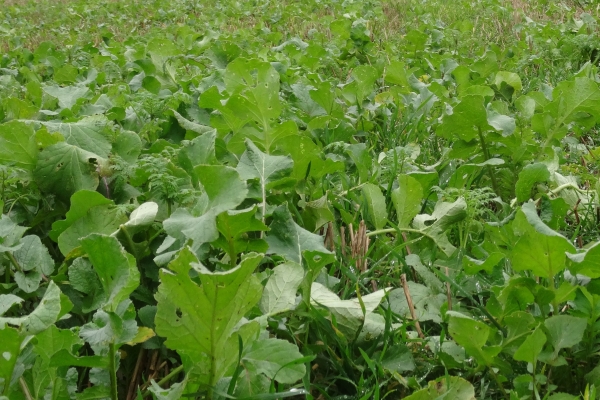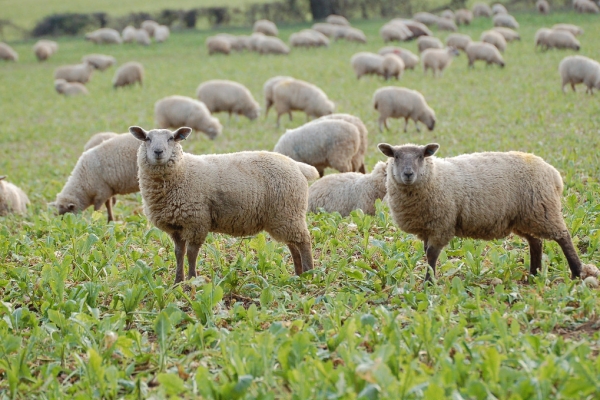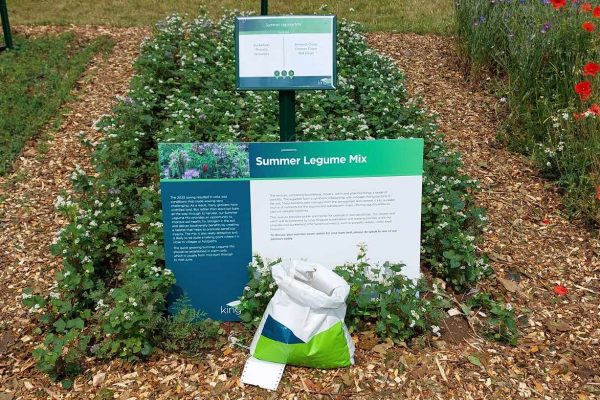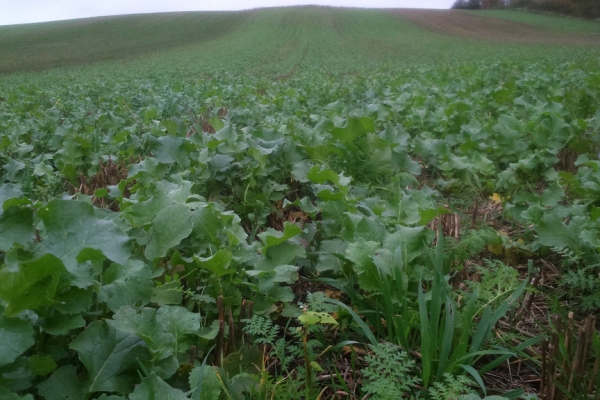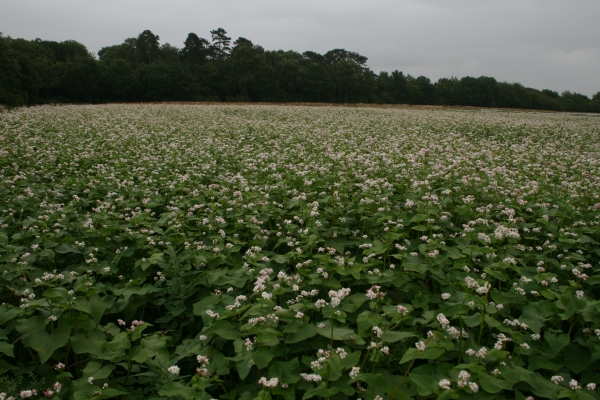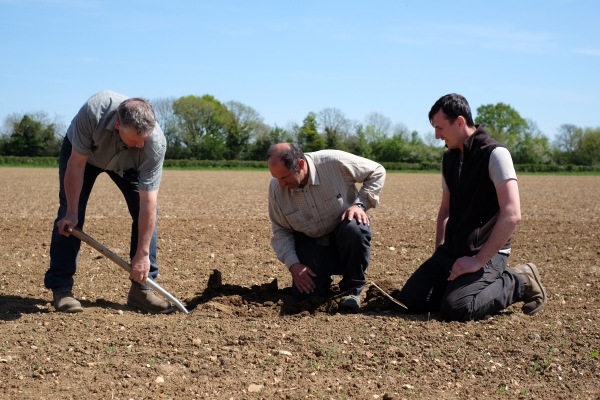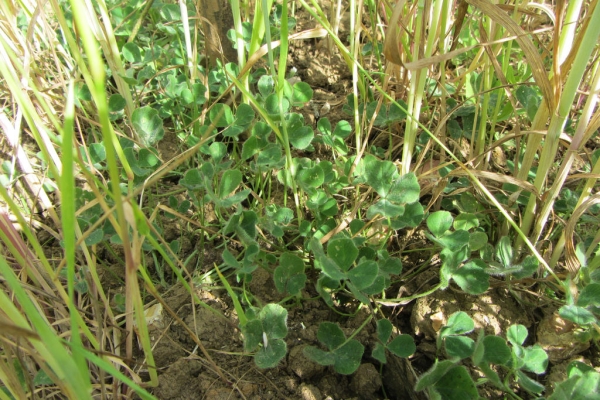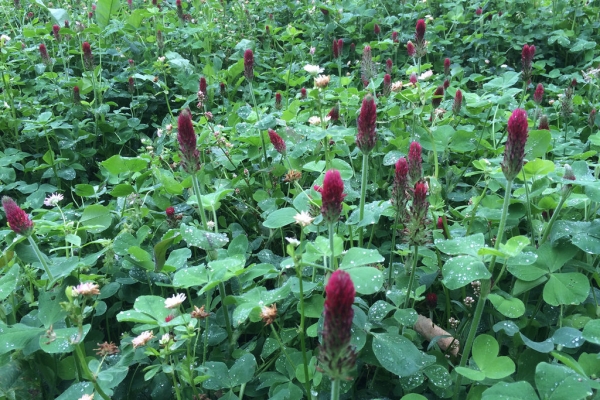Wessex Water Cover Crop Trials
Research Background
Nitrogen (N) is a key input in farm systems for maximising crop growth and yield. Following harvest any residual N in the soil is vulnerable to leaching, and soils may be left exposed to erosion and runoff if harvest is late e.g. after maize. Cover crops can be grown to utilise some of this leftover N, preventing it from leaching, as well as providing several other agronomic and environmental benefits such as carbon capture, soil structural improvement and increased soil cover in order to prevent run- off. They can be grown either as single species or in mixes. Mixes are an effective way of combining the benefits of different species, with their varying rooting structures, agronomic benefits and effect on soil health. Oil radish is a widely grown cover crop as it is very effective at capturing N (up to 70kgN/ha) that might otherwise leach. Brassicas like oil radish are not however suited to all farming systems, as they are susceptible to the same agronomic challenges as oilseed rape is; slugs, club root and the need for early establishment.
Winter 2017-2018
Trials held in at Kingston Maurward College (KMC), near Dorchester in Dorset looked at the effectiveness of different cover crop mixes and some non-brassica options drilled on two drilling dates at taking up N and reducing nitrate leaching.

Aims & Objectives
- What are the most effective alternatives to brassica cover crops for reducing N leaching?
- Which species and mixes of cover crops are best suited to different drilling dates?
Winter 2016-2017
Trials held in Dorset at Deverel Farm, Milborne St Andrew and at Kingston Maurward College (KMC), near Dorchester (pictured below) looked into how drilling date and cover crop species can be used to optimise the effectiveness of a cover crop for reducing nitrate leaching.


Aerial photos of trials at a) Deverel Farm, b) Kingston Maurward College. Taken on 22nd November 2016
Aims & Objectives
- What is the optimum drilling date to achieve maximum N uptake, thereby reducing N leaching?
- Which varieties and species are best for withstanding winter conditions and achieving maximum N uptake?
- Which varieties and species are best suited for different drilling dates?
Trial Design
Winter 2017-2018
The trial followed an early harvest of wheat and intended to be drilled into maize the following spring. The trial focused on a number of cover crop species as listed in the table below and were drilled in 4 x 25m strips on the following dates:
- Drilling date 1: 22nd August 2017
- Drilling date 2: 29th September 2017

Below shows the basic layout of the site. Each plot was replicated for both drilling dates. Two control strips were used to compare the leaching from a bare overwinter stubble. The central strip was used for vehicle movements.

Soil Mineral Nitrogen (SMN) samples were taken in September, on average SMNs were 109kgN/ha. Some plots were sampled in February, on average SMNs were 15kgN/ha where a cover crop had been grown and 28kgN/ha in the control plot. The N loss between autumn and spring SMNs will either have been leached or taken up by the cover crop.
Winter 2016-2017
The Deverel Farm trial focused on comparing different oil radish varieties plus one multi species mix, all drilled on the same date. The KMC trial looked at different species of cover crops including mustard, cereals, grass, plus the same varieties of oil radish used at Deverel Farm. Below show the plot layouts, with plots being replicated at both sites. The previous crop at both sites was a cereal. The sites were drilled on the following dates to represent establishment after cereals (dates 1 & 2) and maize (dates 3 &4):
- Drilling date 1: 25th August 2016 (Deverel Farm) – Oil radish only & 1 mix
- Drilling date 2: 7th September 2016 (KMC)
- Drilling date 3: 28th September 2016 (KMC)
- Drilling date 4: 21st October 2016 (KMC) – only some species
Plots were sampled for soil mineral nitrogen (SMN) content just before drilling of the cover crop. The Deverel Farm plots had 85kgN/ha and the KMC plots had 63kgN/ha on average.
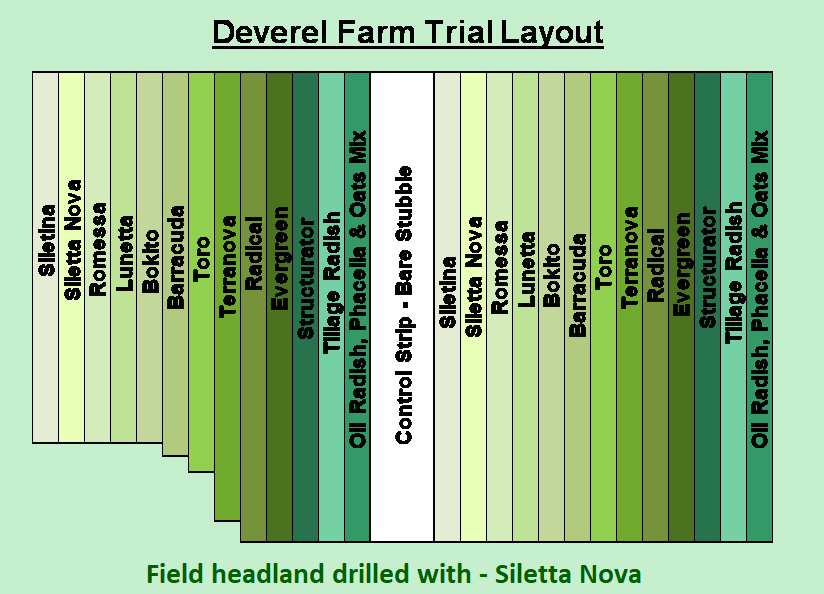

Findings & Recommendations
Winter 2017-2018
Key findings
- Earliest sown cover crops are most effective at reducing nitrate (N) leaching.
- Oil radish had the greatest uptake of N when drilled early (late August), containing up to 70kgN/ha that may be prevented from leaching. Later drilled cover crops took up between 5 and 28kgN/ha.
- Where brassicas are not an option, other species such as Italian ryegrass, Westerwolds, barley and oats are considered to be effective alternatives.
Results
Porous pots
Porous pots were installed in selected plots to measure N leaching and calculate how much N was cumulatively lost through the winter. The total amount of N leached from different crops is shown below. The red line represents average leaching from bare stubble plots.

- Leaching was reduced when a cover crop was planted on both drilling dates, compared to leaving a bare stubble.
- Non-brassica species were slower to establish.
- Cover crop species such as IRG or a mix of spring oats and phacelia are effective alternatives to brassicas.
Crop tissue
Leaf tissue samples were taken to measure how much N had been taken up by the plant in the leaf and root and therefore prevented from leaching.

- Earliest sown crops had the greatest up take of N containing between 9kgN/ha – 63kgN/ha. Later sown cover crops took up between 5kgN/ha and 28kgN/ha.
- Overall, plots containing oil radish demonstrated the greatest N uptake.
- Non- brassica species grown in a mix performed better as part of a mix compared to when they were grown alone, whilst also providing greater ground cover and a variety of rooting systems/depths.
Conclusions
- Earliest sown brassicas were the most effective at reducing N leaching and had the greatest accumulation of N. Contrary to expectation, this was the case even at the later drilling dates.
- Although N uptake in cereals and grasses was lower than in brassicas across all drilling dates, they may still be considered when brassica cover crops are not an option available to the farmer.
Winter 2016-2017
Key findings
- Earliest sown cover crops are most effective at reducing nitrate (N) leaching.
- Oil radish had the greatest uptake of N when drilled early, containing up to 70kgN/ha that may be prevented from leaching.
- Where brassicas are not an option e.g. following maize, other species such as Italian ryegrass, Westerwolds, barley and oats are considered to be effective cover crops.
- Nitrate leaching increased as drilling date became later, with the latest sown cover crops leaching more than a bare stubble.
Results
Porous pots
Porous pots were installed in selected plots to measure N leaching and calculate how much cumulative N was lost through the winter. The total amount of N leached from different crops is shown below. The red line represents average leaching from bare stubble plots.
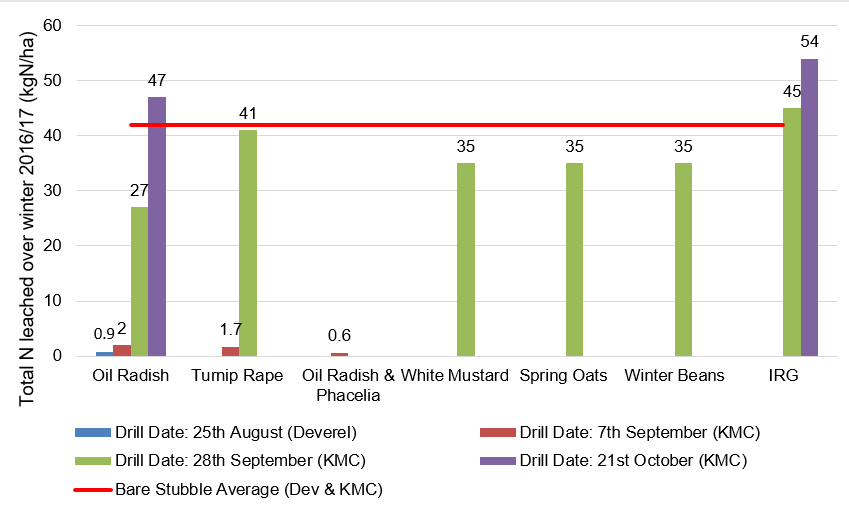
- Early sown crops leached very little N (<2 kg/ha) over the winter period. Good establishment meant that crops grew quicker and took up more N, thereby preventing it from leaching.
- The control plots leached between 39 & 45kgN/ha over the two sites (42kgN/ha on average). The dry winter meant that leaching was lower than expected. If the weather had been wetter, more N would have been expected to leach.
- Leaching from the later sown cover crops (21st October) was greatest, at up to 54kgN/ha. This was due to poor establishment and probable mineralisation of soil N from the drilling process. This suggests that there is a point in the autumn when it is too late to establish a cover crop and more leaching may be caused by drilling a cover crop than if the field had been left uncropped.
Therefore, in practice, if weather conditions delay operations/drilling then drilling a cover crop may not reduce nitrate leaching and may also cause further damage through soil compaction. Although nitrate leaching can be higher from very late sown cover crops than if the field had been left uncultivated, even a late sown cover crop can create enough ground cover to improve soil structure and reduce run-off and soil erosion, as long as ground conditions are suitable at the time of drilling. Choosing earlier maturing varieties of maize should enable earlier drilling of the following cover crop.
Crop tissue
Leaf tissue samples were also taken to measure how much N had been taken up by the plant in the leaf and root. The graph below shows the uptake across the different oil radish varieties and other brassicas.

- The greatest uptake of total crop N was in the early sown brassicas which contained 25-65kgN/ha. There was wide variation between varieties.
- Toro was the best performing oil radish variety with good groundcover and crop N uptake.
- In oil radish, on average, across all drilling dates, 1/3 of crop N was found in the root and 2/3 in the leaf.
- Tillage radish contained 70kgN/ha, when drilled in August. Due to its large tap root, approximately half of this N was in the root.
- Barracuda had the lowest crop N uptake across all three drilling dates, reflecting its unsuitability for drilling later than mid-August.
- Romessa, an early flowering variety, started flowering in November at the Deverel Farm site. This is a characteristic that should be considered when choosing cover crop varieties.
Below shows the total crop N for the non-brassica options and mixes. In general, growth and N uptake in non-brassica species was significantly lower than in the brassicas, and was less than expected in all plots. However in some situations, such as following maize or when there is oilseed rape in the rotation, non-brassica species may be the only option available.

- Westerwolds and oats showed the highest N uptake when drilled in early September, containing 17kgN/ha in both species.
- Spring barley had a greater N uptake in the late September drilled plots at 16kgN/ha.
- Unfavourable weather conditions in the latest sowing window led to very limited crop cover, and consequently very low N uptake.
Conclusions
- Earliest sown brassicas were the most effective at reducing N leaching and had the greatest accumulation of N.
- Although N uptake in cereals and grasses was lower than in brassicas across all drilling dates, they may still be considered when brassica cover crops are not an option available to the farmer.
- Very late sown cover crops drilled in unfavourable weather conditions may do more harm than good if they do not establish properly. However, although nitrate leaching can be higher from very late sown cover crops than if the field had been left uncultivated, even a late sown cover crop can often create enough ground cover to improve soil structure and reduce run-off and soil erosion, as long as ground conditions at the time of drilling are suitable.
- Choosing earlier maturing varieties of maize means that cover crops can be established earlier and therefore stand a greater chance of success.

Header image shows cover crop at Deverell Farm. Courtesy of Timothy Stephens, Wessex Water
